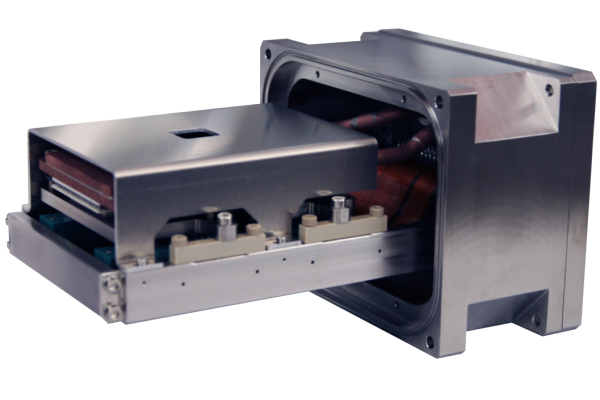IT-8-P-1696 New Operation Modes with the direct detecting pnCCD-camera in Transmission Electron Microscopy
The pnCCD’s ability to directly detect and image single electrons in a transmission electron microscope (TEM) at energies from 300 to 80 keV has already been demonstrated [1,2] with the dedicated mechanical setup shown in Fig. 1. For these measurements a pnCCD with a physical pixel size of 48x48 μm² with 264x264 pixels was read out as fast as 1000 fps. At low dose conditions a sub-pixel resolution of 1320x1320 after processing of the raw data has been reached. Meanwhile the pnCCD-camera was used to detect TEM electrons with energies down to 20 keV.
A common limitation of CCD-based cameras is the charge handling capacity. Primary electrons from the TEM generate many signal electrons when they scatter in the bulk of the pnCCD. These electrons are stored in potential wells (the pixels) until the CCD is read out. If the number of signal electrons in one pixel exceeds its charge handling capacity, surplus electrons will spill over to neighboring pixels. This effect is usually called “blooming”.
In order to have an optimal behavior of the pnCCD-camera under many different experimental conditions, several new operation modes were developed. While the normal operation settings offer the best spectroscopic properties of the camera, especially at very low energies, the charge handling capacity is limited to about five 80 keV electrons per pixel and frame, i.e. 1 ms. In the high charge handling capacity (HCHC) mode this can be increased by a factor of 3 to 4 without noteworthy losses of other performance parameters. This means, for a primary electron energy of 80 keV and a readout rate of 1000 fps, up to 16,000 TEM electrons per pixel can be processed during one second.
To process even higher electron rates the anti-blooming (AB) mode is available. In this operation mode the number of electrons that can be stored in one pixel is reduced compared to the HCHC mode but excess charge does not overflow into neighboring pixels. Instead it is drained from the detector and does not contribute to the readout signal. Therefore it is possible to image spots of very high intensity without degrading spatial information. At the same time single electrons can be detected in other sections of the detector.
The XPLUS mode is a hybrid of HCHC and AB mode. The charge handling capacity is increased compared to the AB mode, while overflowing signal electrons are drained off.
In the presentation the advantages of the different operation modes will be explained and visualized by different measurements under varying TEM conditions and primary electron energies from 300 to 20 keV.
[1] H. Ryll et al., Microscopy and Microanalysis 19 (2013), p.1160-1161.
[2] K. Müller et al., Appl. Phys. Lett. 101 (2012), p. 2121101-2121104.

